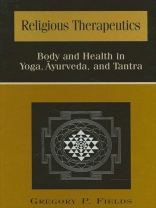Religious Therapeutics explores the relationship between psychophysical health and spiritual health and presents a model for interpreting connections between religion and medicine in world traditions. This model emerges from the work’s investigation of health and religiousness in classical Yoga, Āyurveda, and Tantra–three Hindu traditions noteworthy for the central role they accord the body. Author Gregory P. Fields compares Anglo-European and Indian philosophies of body and health and uses fifteen determinants of health excavated from texts of ancient Hindu medicine to show that health concerns the person, not the body or body/mind alone. This book elucidates multifaceted views of health, and–in the context of spirituality and healing–explores themes such as mental health, meditation, and music.
Daftar Isi
List of Figures and Tables
Acknowledgments
Symbols and Notes on Sources
Abbreviations
Introduction
THE IDEA OF RELIGIOUS THERAPEUTICS
Religion and Medicine
A Model of Religious Therapeutics
Chapter One
BODY AND PHILOSOPHIES OF HEALING
Body in Western Philosophy of Medicine
Presuppositions about the Body
Descartes on Body and Medicine
Body in the History of Western Medicine
Iconoclastic Concepts of Body in Yoga, Tantra, and Ayurveda
Traditional Indian Views of Person and Body
Yoga’s Use of the Body to Transcend Itself
Tantra’s Enlightenable Body
Body as the Ground of Well-being in Ayurveda
Chapter Two
MEANINGS OF HEALTH IN AYURVEDA
Inquiry into Health
Determinants of Health
Biological and Ecological Determinants
Life, Development, and Longevity
Equilibrium
Adaptation
Non-susceptibility
Vitality, Endurance, and Relaxation
Medical and Psychological Determinants
Normality
Freedom from Pain
Wholeness and Integration
Awareness and Mental Clarity
Socio-cultural and Aesthetic Determinants
Relationality
Creativity
Generativity
Enjoyment
Metaphysical and Religious Determinants
Self-identity
Freedom
Ayurvedic Religious Therapeutics
Chapter Three
CLASSICAL YOGA AS A RELIGIOUS THERAPEUTIC
Meanings and Forms of Yoga
Meanings of ‘Yoga’ 85
Yoga in the Vedas, Upanisads, and Bhagavadgıta
Yoga in the Vedas
Yoga in the Upanisads
Yoga in the Bhagavadgita
Traditions of Yoga Practice
A Matrix of Classical Yoga as a Religious Therapeutic
Metaphysical and Epistemic Foundations
Yoga’s Therapeutic Paradigm
Yoga’s Diagnosis of the Human Condition
The Yogic Remedy
Soteriology
Self-realization by Healing the Af
Value Theory and Ethics: Health and the Good in Yoga
First Limb: Moral Self-restraints—Yama
Second Limb: Moral Commitments—Niyama
Physical Practice: The Soteriological Role of Body and Health in Yoga
Third Limb: Postures—Asana
Fourth Limb: Regulation of Vital Energy Through Breath—Pranayama
Fifth Limb: Withdrawal of the Senses—Pratyahara
Cultivation of Consciousness: The Polarity of Samadhi and
Vyadhi (Illness)
Sixth Limb: Concentration—Dharana
Seventh Limb: Meditation—Dhyana
Eighth Limb: Meditative Trance—Samadhi
Liberation as Healing in Classical Yoga
Healing and Yoga’s Therapeutic Paradigm
Wholeness and Holiness
Identity and Freedom
Chapter Four
TANTRA AND AESTHETIC THERAPEUTICS
Body and Tantric Yogas
Features of Tantric Practice
Sexuality in Tantra
Kundalinı Yoga
Mantra Yoga
Aesthetic Therapeutics in Tantra
Therapeutic Elements of Tantra
Sacred Music
Sacred Music as a Religious Therapeutic
How Is Sacred Music Therapeutic?
Breath, Music, and Healing
Body as Instrument of Sacred Music
Elements of Healing in Sanskrit Chant
Healing in Identi
Sound as a Bridge Between Substantial and Non-substantial Being
Conclusion
COMMUNITY:
RELATIONALITY IN RELIGIOUS THERAPEUTICS
Notes
Sources
Indices
Subject Index
Sanskrit Terms
Index of Names
Sanskrit Texts
Tentang Penulis
Gregory P. Fields is Associate Professor of Philosophy at Southern Illinois University–Edwardsville.







![Sampul Brian Schrag & Julisa Rowe: Community Arts for God's Purposes [Chinese] 貼近神心意的社群藝術 Sampul Brian Schrag & Julisa Rowe: Community Arts for God's Purposes [Chinese] 貼近神心意的社群藝術](https://static.worldofdigitals.com/thumb_webp/740/9781645083740.webp)




